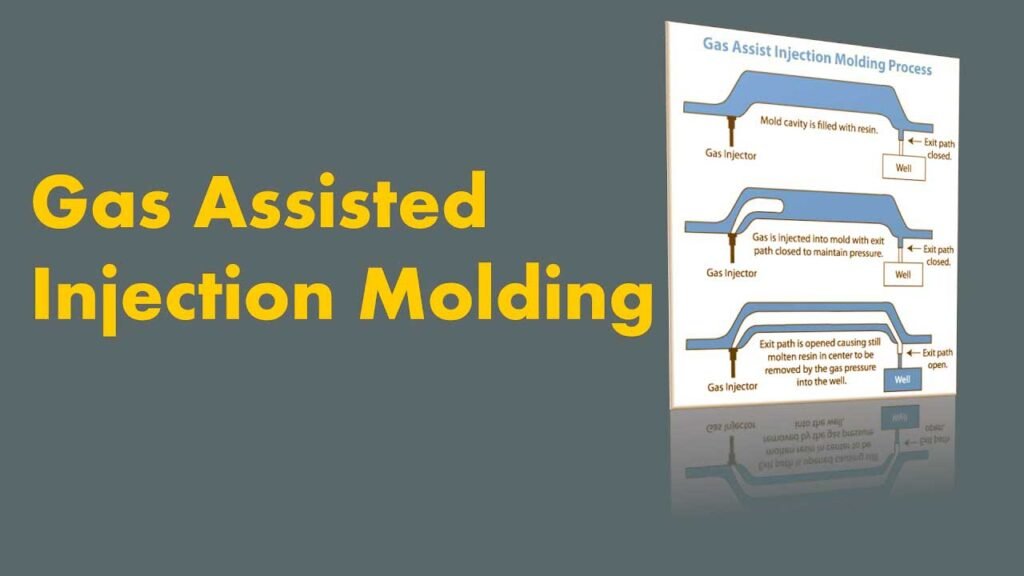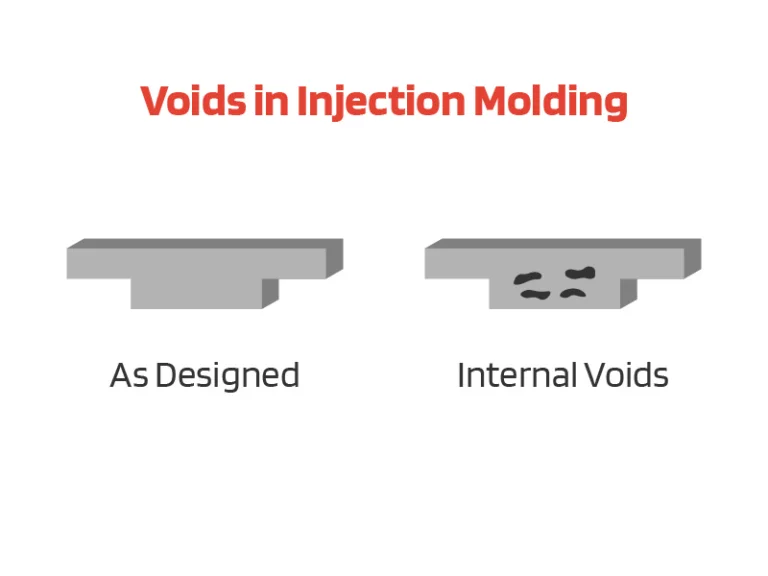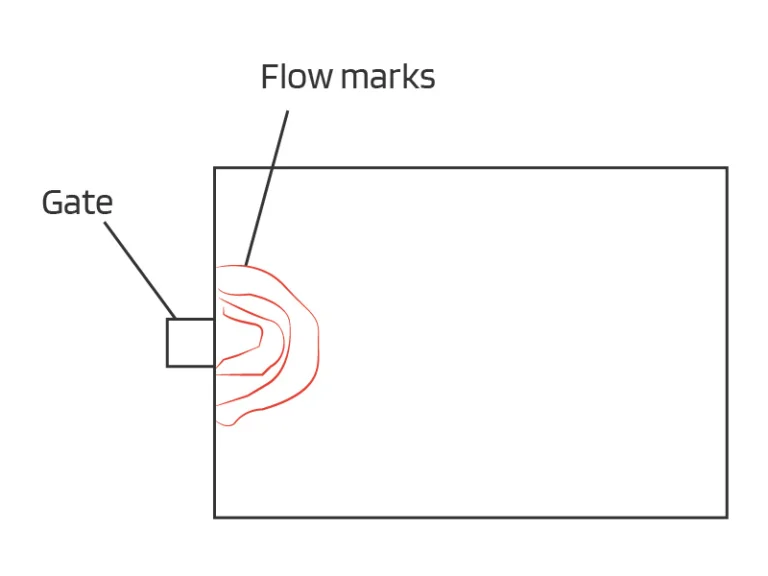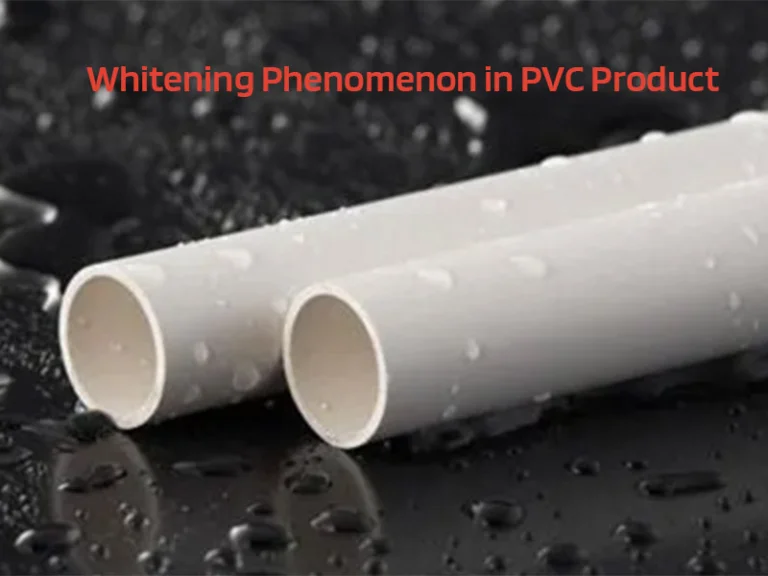Gas Assisted Injection Molding (GAIM), is a revolutionary process that enhances the versatility and efficiency of plastic part production. It was first started in the 1970s, then the process gained significant momentum in the 1980s and 1990s, with advancements in molding technology and the introduction of new materials. In this post, we will explore the gas-assisted injection molding processes, plastic materials, applications, advantages and disadvantages, etc.
What’s Gas-Assisted Injection Molding?
Gas Assisted Injection Molding (GAIM) is an advanced plastic molding technique that involves the strategic introduction of pressurized gas into the mold cavity during the injection molding process. The gas displaces molten plastic, creating hollow sections or channels within the part, thereby reducing material usage and enhancing part quality.
In conventional injection molding, the molten plastic fills the entire mold cavity, resulting in solid plastic parts. However, with gas-assisted injection molding, the gas is injected into the mold at a specific point in the process. This gas pushes the plastic against the walls of the mold, forming a hollow center while maintaining the desired shape and structure of the part.
The gas used in the process can be nitrogen or other inert gases. It is carefully controlled to achieve the desired hollow geometry without causing any distortion or deformation in the part.
Types of Gas Assist Injection Molding Processes
There are two primary types of Gas Assist Injection Molding (GAIM) processes: Internal Gas Assist Injection Molding and External Gas Assist Injection Molding. Let’s explore each type in detail:
Internal Gas Assist Injection Molding
In Internal Gas Assist Injection Molding, the gas is injected directly into the molten plastic inside the mold cavity. The gas displaces the molten plastic, creating a hollow section within the part. The gas is injected through special gas pins or channels integrated into the mold design. These pins allow the gas to flow through the part and form the desired hollow geometry.
Internal gas-assist molding is suitable for parts with thick cross-sections or areas that are prone to sink marks. By introducing gas, the thick sections are hollowed out, reducing material usage and minimizing sink marks on the part’s surface.
External Gas Assist Injection Molding
In External Gas Assist Injection Molding, the gas is injected outside the mold cavity, between the mold surface and the solidified plastic part. The gas flows through specially designed gas channels on the external surface of the mold, displacing the molten plastic inside the mold cavity. This creates hollow sections within the part without affecting the part’s external appearance.
External gas-assist molding is often used for complex parts with intricate geometries or those requiring multiple hollow channels. It offers design flexibility and allows for the creation of parts with varied wall thicknesses and internal cavities.
Both types of gas-assist injection molding processes offer advantages in terms of material savings, reduced cycle times, improved part quality, and enhanced design possibilities. The choice between the two methods depends on the specific requirements of the part and the desired hollow geometries within the design.
Materials Used for Gass Assist Injection Molding
Gas-assisted injection molding can be used with a wide range of materials. The selection of the material depends on the specific requirements of the part and the desired characteristics of the final product. Some common materials used for gas-assisted molding include:
- Polypropylene (PP): Polypropylene is a versatile thermoplastic known for its high impact resistance and excellent chemical resistance. It is commonly used in gas-assisted molding for parts that require toughness and dimensional stability.
- Polyethylene (PE): Polyethylene is another widely used thermoplastic that offers good strength, flexibility, and chemical resistance. It is suitable for gas-assisted molding of parts where lightweight and cost-effectiveness are essential.
- Polycarbonate (PC): Polycarbonate is a transparent thermoplastic known for its high impact resistance and optical clarity. It is often used in gas-assisted molding for parts requiring transparency and superior mechanical properties.
- Nylon (PA): Nylon is a strong and durable thermoplastic with excellent wear resistance and low friction. It is suitable for gas-assisted molding of parts that require high strength and toughness.
- Acrylonitrile Butadiene Styrene (ABS): ABS is a versatile thermoplastic known for its excellent impact resistance and ease of processing. It is commonly used in gas-assisted molding for automotive components, consumer goods, and electronic enclosures.
- Polyethylene Terephthalate (PET): PET is a lightweight and strong thermoplastic used in gas-assisted molding for bottles, containers, and other packaging applications.
- Polystyrene (PS): Polystyrene is a cost-effective thermoplastic with good electrical insulating properties. It is suitable for gas-assisted molding of parts requiring low cost and ease of processing.
Applications of Gas-Assisted Injection Molded Plastic Parts
As gas-assisted molding can manufacture lightweight, intricately designed, and cost-effective components, gas-assisted molded plastic parts find applications in a wide range of industries. Some common applications include:
Automotive Industry
Gas-assisted molded parts are used in automotive components such as door panels, dashboard parts, seat frames, and interior trim. The reduced weight and improved stiffness of gas-assisted parts contribute to increased fuel efficiency and overall vehicle performance.
Furniture Manufacturing
Gas-assisted molding is employed to produce lightweight yet strong furniture components, including chair seats, backrests, and table bases. The hollow sections reduce material usage while maintaining structural integrity.
Consumer Goods
Gas-assisted molding is utilized to create various consumer products, such as appliance housings, containers, and recreational equipment. The process enables intricate designs and enhanced functionality in these products.
Electronics and Electrical Components
Gas-assisted molding is used to manufacture electronic enclosures, connectors, and structural components for electronic devices. The method allows for complex shapes and optimal space utilization.
Advantages of Gas Assist Injection Molding
Gas assist molding offers several advantages that make it a popular and effective technique in the injection molding industry. Some key advantages of gas assist molding include:
Material Savings
Gas assist molding allows for the creation of hollow sections within the part, reducing material usage significantly. This results in cost savings and helps to lower overall material expenses.
Reduced Part Weight
By incorporating hollow sections, gas assist molding produces lighter parts without compromising strength or structural integrity. The reduced weight contributes to improved fuel efficiency in automotive applications and easier handling in various industries.
Enhanced Part Quality
Gas assist molding minimizes sink marks, warpage, and internal stress in thick-walled sections. The process results in parts with better surface finish and improved dimensional stability.
Design Flexibility
The gas assist molding process offers greater design freedom, enabling the creation of intricate and complex geometries that would be challenging with conventional molding methods.
Improved Cycle Times
Gas assist molding reduces the cooling time needed for thick-walled parts, leading to faster cycle times and increased production efficiency.
Consistent Wall Thickness
The process allows for uniform wall thickness throughout the part, eliminating inconsistencies that may occur with conventional molding methods.
Reduced Post-Processing
Gas assist molding can eliminate the need for secondary operations, such as machining or assembly, as it can achieve complex designs and features in a single molding cycle.
Enhanced Structural Integrity
Gas assist molding enhances the part’s strength and rigidity by creating a uniform skin that surrounds the hollow sections, improving overall structural integrity.
Cost-Effective Solutions
The combination of material savings, reduced cycle times, and minimal post-processing contributes to cost-effective production and improved return on investment.
Disadvantages of Gas Assist Injection Molding
While gas assist molding offers various benefits, there are also some potential disadvantages to consider:
Higher Initial Investment
Implementing gas assist molding may require additional capital investment due to the need for specialized equipment and molds that can handle the gas injection process.
Complex Process Control
Gas assist molding involves precise control of gas flow rates and pressures, which can be challenging and may require skilled operators to ensure consistent part quality.
Design Complexity
Designing parts for gas assist molding can be more complex compared to conventional molding. Properly integrating gas channels and vents into the mold design is crucial for successful gas assist molding.
Gas Handling and Safety
Working with pressurized gas introduces safety considerations. Proper handling, storage, and safety protocols are essential to avoid accidents or hazards.
Limited Applications for Thin-Walled Parts
Gas assist molding is most effective for thick-walled parts. For thin-walled parts, the benefits of gas assist molding may not be as significant, and conventional molding methods might suffice.
Cycle Time Optimization
While gas assist molding can reduce cycle times for thick-walled parts, optimizing the process for specific part geometries and achieving the desired cycle time reduction may require iterative adjustments and testing.
Material Compatibility
Not all plastic materials are suitable for gas assist molding. Some materials may react differently to gas injection, affecting part quality and performance.
Conclusion
In the ever-evolving landscape of plastic manufacturing, gas-assisted injection molding emerges as a formidable choice for complex geometries and unparalleled manufacturing capabilities. With a focus on top-of-the-line quality and design flexibility, it stands as one of the leading options for modern industries. Zhongde, as a China custom manufacturer, is ready to cooperate with you and offer competitive molded products through our professional injection molding service.




